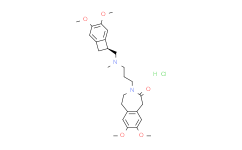| Cas No.: | 148849-67-6 |
| Chemical Name: | Ivabradine HCl |
| Synonyms: | Ivabradine hydrochloride;Ivabradine HCl;3-[3-[[(8S)-3,4-Dimethoxy-8-bicyclo[4.2.0]octa-1,3,5-trienyl]methyl-methylamino]propyl]-7,8-dimethoxy-2,5-dihydro-1H-3-benzazepin-4-one hydrochloride;3-[3-[[[(7S)-3,4-Dimethoxybicyclo[4.2.0]octa-1,3,5-trien-7-yl]methyl]methylamino]propyl]-1,3,4,5-tetrahydro-7,8-dimethoxy-2H-3-benzazepin-2-one Hydrochloride;Corlentor;Procoralan;S-16257;(S)-3-(3-(((3,4-Dimethoxybicyclo[4.2.0]octa-1,3,5-trien-7-yl)methyl)(methyl)amino)propyl)-7,8-dimethoxy-4,5-dihydro-1H-benzo[d]azepin-2(3H)-one hydrochloride;Ivabradine (hydrochloride);3-[3-[[(7S)-3,4-dimethoxy-7-bicyclo[4.2.0]octa-1,3,5-trienyl]methyl-methylamino]propyl]-7,8-dimethoxy-2,5-dihydro-1H-3-benzazepin-4-one,hydrochloride;S 16257-2;2H-3-Benzazepin-2-on;Ivabridine hydracloride;Ivabradine hydrochlorid;Ivabradine HCl (Procoralan);Corlanor;TP19837BZK;2H-3-Benzazepin-2-one, 3-[3-[[[(7S)-3,4-dimethoxybicyclo[4.2.0]octa-1,3,5-trien-7-yl]methyl]methylamino]propyl]-1,3,4,5-tetrahydro-7,8-dimethoxy-, hydrochloride (1:1);(S) |
| SMILES: | Cl[H].O(C([H])([H])[H])C1=C(C([H])=C2C(=C1[H])[C@@]([H])(C([H])([H])N(C([H])([H])[H])C([H])([H])C([H])([H])C([H])([H])N1C(C([H])([H])C3=C([H])C(=C(C([H])=C3C([H])([H])C1([H])[H])OC([H])([H])[H])OC([H])([H])[H])=O)C2([H])[H])OC([H])([H])[H] |
| Formula: | C27H37ClN2O5 |
| M.Wt: | 505.05 |
| Sotrage: | 2 years -20°C Powder, 2 weeks 4°C in DMSO, 6 months -80°C in DMSO |
| Description: | Ivabradine (hydrochloride) is a new If inhibitor with IC50 of 2.9 μM, and used as a pure heart rate lowering agent. |
| In Vivo: | Ivabradine treatment (10 mg/kg/d) induces long-term HRR, and that improves diastolic LV function probably involving attenuated hypoxia, reduced remodeling, and/or preserved nitric oxide bioavailability, resulting from processes triggered early after HRR initiation: angiogenesis and/or preservation of endothelial nitric oxide synthase expression[1]. Ivabradine leads to a sustained 15-20% heart rate reduction, but has no effect on blood pressure. While ivabradine has no effect on endothelial function and vascular reactive oxygen species production in angiotensin II-treated rats, it improves both parameters in ApoE knockout mice. Ivabradine treatment leads to an attenuation of angiotensin II signaling and increased the expression of telomere-stabilizing proteins in ApoE knockout mice, which may explain its beneficial effects on the vasculature. The absence of these protective ivabradine effects in angiotensin II-infused rats may relate to the treatment duration or the presence of arterial hypertension[2]. |






















